Investigation of the Optical Properties of Aerosols over the Coastal Region at Dalian, Northeast China
Abstract
:1. Introduction
2. Site, Instrument and Data
3. Results and Discussion
3.1. Annual and Monthly Variations in the AOD and Ångström Exponent
3.2. Seasonal Variationsin the AOD and Ångström Exponent
3.3. Frequency Distribution of the AOD and Ångström Exponent
3.4. Relationship between AOD, Ångström Exponent, Meteorological Conditions and PM10
3.5. Aerosol Classification by AOD, Ångström Exponent and Ångström Exponent Difference (δα)
3.6.Variations in AOD and Ångström Exponent Values under Dust and Fog Conditions
4. Summary
Acknowledgments
Author Contributions
Conflicts of Interest
References
- Twomey, S.A.; Piepgrass, M.; Wolfe, T.L. An assessment of the impact of pollution on the global cloud Albedo. Tellus 1984, 36B, 356–366. [Google Scholar] [CrossRef]
- Hansen, J.; Sato, M.; Ruedy, R. Radiative forcing and climate response. J. Geophys. Res. 1997, 102, 6831–6864. [Google Scholar] [CrossRef]
- Hansen, J.; Sato, M.; Ruedy, R.; Lacis, A.; Oinas, V. Global warming in the twenty-first century: An alternative scenario. Proc. Nat. Acad. Sci. USA 2000, 97, 9875–9880. [Google Scholar] [CrossRef]
- Charlson, R.J.; Schwartz, S.E.; Hales, J.M.; Cess, D.; Coakley, J.A.; Hansen, J.E. Climate forcing by anthropogenic aerosols. Science 1992, 255, 423–430. [Google Scholar] [CrossRef] [PubMed]
- Watson, J.G. Visibility: Science and regulation. J. Air. Waste. Manag. Assoc. 2002, 52, 628–713. [Google Scholar] [CrossRef] [PubMed]
- Menon, S.; Hansen, J.E.; Nazarenko, L.; Luo, Y.F. Climate effects of black carbon aerosols in China and India. Science 2002, 297, 2249–2252. [Google Scholar] [CrossRef] [PubMed]
- Sharma, M.; Kaskaoutis, D.G.; Singh, R.P.; Singh, S. Seasonal variability of atmospheric aerosol parameters over Greater Noida using ground sun photometer observations. Aerosol Air Qual. Res. 2014, 14, 608–622. [Google Scholar]
- Myhre, G. Consistency between satellite-derived and modeled estimates of the direct aerosol effect. Science 2009, 325, 187–190. [Google Scholar] [CrossRef] [PubMed]
- Eck, T.F.; Holben, B.N.; Dubovik, O.; Smirnov, A.; Goloub, P.; Chen, H.B.; Chatenet, B.; Gomes, L.; Zhang, X.Y.; Tsay, S.C.; et al. Columnar aerosol optical properties at AERONET sites in central eastern Asia and aerosol transport to the tropical Mid-Pacific. J. Geophys. Res. 2005, 110. [Google Scholar] [CrossRef]
- Intergovernmental Panel on Climate Change (IPCC). Climate Change 2013. The Scientific Basis; Cambridge University Press: New York, NY, USA, 2013. [Google Scholar]
- Obregon, M.A.; Serrano, A.; Cancillo, M.L.; Cachorro, V.E.; Toledano, C. Aerosol radiometric properties at Western Spain (Caceres station). Int. J. Climatol. 2014, 35, 981–990. [Google Scholar] [CrossRef]
- Panicker, A.S.; Lee, D.I.; Kumkar, Y.V.; Kim, D.; Maki, M.; Uyeda, H. Decadal climatological trends of aerosol optical parameters over three different environments in South Korea. Int. J. Climatol. 2013, 33, 1909–1916. [Google Scholar] [CrossRef]
- Kaufman, Y.J.; Tanré, D.; Boucher, O. A satellite view of aerosols in the climate system. Nature 2002, 419, 215–223. [Google Scholar] [CrossRef] [PubMed]
- Holben, B.N.; Tanre, D.; Smirnov, A.; Eck, T.F.; Slutsker, I.; Abuhassan, N.; Newcomb, W.W.; Schafer, J.; Chatenet, B.; Lavenu, F.; et al. An emerging ground-based aerosol climatology: Aerosol optical depth from AERONET. J. Geophys. Res. 2001, 106, 12067–12097. [Google Scholar] [CrossRef]
- Dubovik, O.; Holben, B.N.; Eck, T.F.; Smirnov, A.; Kaufman, Y.J.; King, M.D.; Tanre, D.; Slutsker, I. Variability of absorption and optical properties of key aerosol types observed in worldwide locations. J. Atmos. Sci. 2002, 59, 590–608. [Google Scholar] [CrossRef]
- Russell, P.B.; Bergstrom, R.W.; Shinozuka, Y.; Clarke, A.D.; DeCarlo, P.F.; Jimenez, J.L.; Livingston, J.M.; Redemann, J.; Dubovik, O.; Strawa, A. Absorption angstrom exponent in AERONET and related data as an indicator of aerosol composition. Atmos. Chem. Phys. 2010, 10, 1155–1169. [Google Scholar] [CrossRef]
- Giles, D.M.; Holben, B.N.; Eck, T.F.; Sinyuk, A.; Smirnov, A.; Slutsker, I.; Dickerson, R.R.; Thompson, A.M.; Schafer, J.S. An analysis of AERONET aerosol absorption properties and classifications representative of aerosol source regions. J. Geophys. Res. 2012, 117, 1–16. [Google Scholar] [CrossRef]
- Kim, D.H.; Sohn, B.J.; Nakajima, T.; Takamura, T.; Choi, B.C.; Yoon, S.C. Aerosol optical properties over east Asia determined from ground-based sky radiation measurements. J. Geophys. Res. 2004, 109. [Google Scholar] [CrossRef]
- Holben, B.N.; Eck, T.F.; Slutsker, I.; Tanre, D.; Buis, J.P.; Setzer, A.; Vermote, E.; Reagan, J.A.; Kaufman, Y.; Nakajima, T.; et al. AERONET-A federated instrument network and data archive for aerosol characterization. Remote Sens. Environ. 1998, 66, 1–16. [Google Scholar] [CrossRef]
- Goloub, P.; Li, Z.; Dubovik, O.; Blarel, L.; Podvin, T.; Jankowiak, I.; Lecoq, R.; Deroo, C.; Chatenet, B.; Morel, J.P.; et al. PHOTONS/AERONET sun photometer network overview: Description, activities, results. Proc. SPIE 2007, 6936. [Google Scholar] [CrossRef]
- Bokoye, A.I.; Royer, A.; O’Neill, N.T.; Cliche, P.; Fedosejevs, G.; Teillet, P.M.; Mcarthur, L.J.B. Characterization of atmospheric aerosols across Canada from a Ground-based sun photometer network: Aerocan. Atmos. Ocean. 2001, 39, 429–456. [Google Scholar] [CrossRef]
- Takamura, T.; Nakajima, T. Overview of SKYNET and its activities. Opt. Puray. Apl. 2004, 37, 3303–3308. [Google Scholar]
- Pappalardo, G.; Amodeo, A.; Apituley, A.; Comeron, A.; Freudenthaler, V.; Linné, H.; Ansmann, A.; Bösenberg, J.; D’Amico, G.; Mattis, I.; et al. EARLINET: Towards an advanced sustainable European aerosol Lidar network. Atmos. Meas. Tech. 2014, 7, 2389–2409. [Google Scholar] [CrossRef]
- Che, H.Z.; Zhang, X.Y.; Chen, H.B.; Damiri, B.; Goloub, P.; Li, Z.Q.; Zhang, X.C.; Wei, Y.; Zhou, H.G.; Dong, F.; et al. Instrument calibration and aerosol optical depth validation of the China Aerosol Remote Sensing Network. J. Geophys. Res. 2009, 114. [Google Scholar] [CrossRef]
- Che, H.Z.; Zhang, X.Y.; Xia, X.A.; Goloub, P.; Holben, B.; Zhao, H.; Wang, Y.; Zhang, X.C.; Wang, H.; Blarel, L.; et al. Ground-based aerosol climatology of China: Aerosol optical depths from the China Aerosol Remote Sensing Network (CARSNET) 2002–2013. Atmos. Chem. Phys. 2015, 15, 7619–7652. [Google Scholar] [CrossRef]
- Gui, K.; Che, H.Z.; Chen, Q.L.; Yu, J.; Zheng, Y.; Lu, S.; Wang, H.; Wang, Y.Q.; Zhang, X.Y.; Shi, G.Y. Analysis of the error in retrievals of aerosol optical properties from sun photometer measurements of CARSNET due to a variety of objective factors. Atmosphere 2016, 7. [Google Scholar] [CrossRef]
- Xin, J.; Wang, Y.; Li, Z.; Wang, P.; Hao, W.; Nordgren, B.; Wang, S.; Liu, G.; Wang, L.; Wen, T.; et al. Aerosol optical depth (AOD) and angstrom exponent of aerosols observed by the Chinese Sun Hazemeter Network from August 2004 to September 2005. J. Geophys. Res. 2007, 112. [Google Scholar] [CrossRef]
- Cheng, Y.F.; Wiedensohler, A.; Eichler, H.; Su, H.; Gnacuk, T.E. Aerosol optical properties and related chemical apportionment at Xinken in Pearl River Delta of China. Atmos. Environ. 2008, 42, 6351–6372. [Google Scholar] [CrossRef]
- Che, H.; Shi, G.; Uchiyama, A.; Yamazaki, A.; Chen, H.; Goloub, P.; Zhang, X. Inter comparison between aerosol optical properties by a PREDE sky radiometer and CIMEL sun photometer over Beijing, China. Atmos. Chem. Phys. 2008, 8, 3199–3214. [Google Scholar] [CrossRef]
- Che, H.Z.; Xia, X.A.; Zhu, J.; Wang, H.; Wang, Y.Q.; Sun, J.Y.; Zhang, X.C.; Zhang, X.Y.; Shi, G.Y. Aerosol optical properties under the condition of heavy haze over an urban site of Beijing, China. Environ. Sci. Pollut. Res. 2015, 22, 1043–1053. [Google Scholar] [CrossRef] [PubMed]
- Xia, X.; Chen, H.; Goloub, P.; Zong, X.; Zhang, W.; Wang, P. Climatological aspects of aerosol optical properties in North China Plain based on ground and satellite remote-sensing data. J. Quant. Spectrosc. Radiat. Transf. 2013, 127, 12–23. [Google Scholar] [CrossRef]
- Zhuang, B.L.; Wang, T.J.; Li, S.; Liu, J.; Talbot, R.; Mao, H.T.; Yang, X.Q.; Fu, C.B.; Yin, C.Q.; Zhu, J.L.; et al. Optical properties and radiative forcing of urban aerosols in Nanjing, China. Atmos. Environ. 2014, 83, 43–52. [Google Scholar] [CrossRef]
- Gui, K.; Che, H.Z.; Chen, Q.L.; An, L.C.; Zeng, Z.L.; Guo, Z.Y.; Zheng, Y.; Wang, H.; Wang, Y.Q.; Yu, J.; et al. Aerosol optical properties based on ground and satellite retrievals during a serious haze episode in December 2015 over Beijing. Atmosphere 2016, 7. [Google Scholar] [CrossRef]
- Zheng, Y.; Che, H.Z.; Zhao, T.L.; Xia, X.X.; Gui, K.; An, L.C.; Qi, B.; Wang, H.; Wang, Y.Q.; Yu, J.; et al. Aerosol optical properties over Beijing during the World Athletics Championships and Victory Day Military Parade in August and September 2015. Atmosphere 2016, 7. [Google Scholar] [CrossRef]
- Zhang, M.; Ma, Y.Y.; Gong, W.; Zhu, Z.M. Aerosol optical properties of a haze episode in Wuhan based on ground-based and satellite observations. Atmosphere 2014, 5, 699–719. [Google Scholar] [CrossRef]
- Zhang, R.J.; Tao, J.; Ho, K.F.; Shen, Z.X.; Wang, G.H.; Cao, J.J.; Liu, S.X.; Zhang, L.M.; Lee, S.C. Characterization of atmospheric organic carbon and elemental carbon of PM2.5 in a typical semi-arid area of Northeastern China. Aerosol Air Qual. Res. 2012, 12, 792–802. [Google Scholar] [CrossRef]
- Cheng, T.T.; Liu, Y.; Lu, D.R.; Xu, Y.F.; Li, H.Y. Aerosol properties and radiative forcing in HunshanDakeDesert, northern China. Atmos. Environ. 2006, 40, 2169–2179. [Google Scholar] [CrossRef]
- Xia, X.; Chen, H.; Goloub, P.; Zhang, W.; Chatenet, B.; Wang, P. A compilation of Aerosol optical properties and calculation of direct radiative forcing over an urban region in northern China. J. Geophys. Res. 2007, 112. [Google Scholar] [CrossRef]
- Xia, X.; Chen, H.; Li, Z.; Wang, P.; Wang, J. Significant reduction of surface solar irradiance induced by aerosols in a suburban region in Northeastern China. J. Geophys. Res. 2007, 112. [Google Scholar] [CrossRef]
- Zhao, H.J.; Che, H.Z.; Ma, Y.J.; Xia, X.A.; Wang, Y.F.; Wang, P.; Wu, X.C. Temporal variability of the visibility, particulate matter mass concentration and aerosol optical properties over an urban site in Northeast China. Atmos. Res. 2015, 166, 204–212. [Google Scholar] [CrossRef]
- Zhao, H.J.; Che, H.Z.; Zhang, X.Y.; Ma, Y.J.; Wang, Y.F.; Wang, X.X.; Liu, C.; Hou, B.; Che, H.C. Aerosol optical properties over urban and industrial region of Northeast China by using ground-based sun-photometer measurement. Atmos. Environ. 2013, 75, 270–278. [Google Scholar] [CrossRef]
- Wang, P.; Che, H.Z.; Zhang, X.C.; Song, Q.L.; Wang, Y.Q.; Zhang, Z.H.; Dai, X.; Yu, D.J. Aerosol optical properties of regional background atmosphere in Northeast China. Atmos. Environ. 2010, 44, 4404–4412. [Google Scholar] [CrossRef]
- Wu, Y.; Zhu, J.; Che, H.; Xia, X.; Zhang, R. Column-integrated aerosol optical properties and direct radiative forcing based on sun photometer measurements at a semi-arid rural site in Northeast China. Atmos. Res. 2015, 157, 56–65. [Google Scholar] [CrossRef]
- Wu, Y.F.; Zhang, R.J.; Pu, Y.F.; Zhang, L.M.; Ho, K.F.; Fu, C.B. Aerosol optical properties observed at a semi-arid rural site in Northeastern China. Aerosol Air Qual. Res. 2012, 12, 503–514. [Google Scholar] [CrossRef]
- Wang, Y.; Shi, H.Q.; He, M.Y.; Huang, S.X. Distribution of atmospheric aerosol optical depth in Southeast China and coastland. Res. Environ. Sci. 2010, 23, 634–641. [Google Scholar]
- Luo, Y.F.; Li, W.L.; Zhou, X.J. Analysis of the 1980’ atmospheric aerosol optical depth over China. Acta Meteorol. Sin. 2001, 59, 77–87. [Google Scholar]
- Luo, Y.F.; Lv, D.R.; He, Q.; Wang, F. An analysis of direct solar radiation, visibility and aerosol optical depth in South China coastal area. Clim. Environ. Res. 2000, 5, 36–44. (In Chinese) [Google Scholar]
- Luo, Y.F.; Lv, D.R.; Zhou, X.J.; Li, W.L. Analyses on the spatial distribution of aerosol optical depth over China in recent 30 years. Chin. J. Atmos. Sci. 2002, 26, 721–730. (In Chinese) [Google Scholar]
- Xu, Q.; Zhu, X.H.; Henkelmann, B.; Schramm, K.; Chen, J.P.; Ni, Y.W.; Wang, W.; Pfister, G.; Mu, J.; Qin, S.T.; et al. Simultaneous monitoring of PCB profiles in the urban air of Dalian, China with active and passive samplings. J. Environ. Sci. 2013, 25, 133–143. [Google Scholar] [CrossRef]
- Zhang, X.Y.; Jiang, H.; Zhang, Q.X.; Zhang, X. Chemical characteristics of rainwater in Northeast China, a case study of Dalian. Atmos. Res. 2012, 116, 151–160. [Google Scholar] [CrossRef]
- Liu, W.; Jin, Y.H.; Quan, X.; Sasaki, K.; Saito, N.; Nakayama, S.; Sato, I.; Tsuda, S. Perfluorosulfonates and perfluorocarboxylates in snow and rain in Dalian, China. Environ. Int. 2009, 35, 737–742. [Google Scholar] [CrossRef] [PubMed]
- Tao, R.; Che, H.Z.; Chen, Q.L.; Wang, Y.Q.; Sun, J.Y.; Zhang, X.C.; Lu, S.; Guo, J.P.; Wang, H.; Zhang, X.Y. Development of an integrating sphere calibration method for Cimelsunphotometers in China aerosol remote sensing network. Particuology 2014, 13, 88–99. [Google Scholar] [CrossRef]
- Smirnov, A.; Holben, B.N.; Eck, T.F.; Dubovik, O.; Slutsker, I. Cloud screening and quality control algorithms for the AERONET data base. Remote Sens. Environ. 2000, 73, 337–349. [Google Scholar] [CrossRef]
- Gobbi, G.P.; Kaufman, Y.J.; Koren, I.; Eck, T.F. Classification of aerosol properties derived from AERONET direct sun data. Atmos. Chem. Phys. 2007, 7, 453–458. [Google Scholar] [CrossRef]
- Cao, X.C.; Shao, L.M.; Wang, X.X. Analysis of climate characteristics of low atmospheric visibility at Dalian. Mar. Forecast. 2011, 28, 44–49. (In Chinese) [Google Scholar]
- Guo, B.J.; He, Q.S.; Li, C.C.; Mao, J.T.; Xin, T.E.; Chen, X.Z.; Li, H.B.; Huang, T.; Song, Y. Remote sensing study of a dust event over Dalian. J. Nanjing Inst. Meteorol. 2008, 31, 624–632. (In Chinese) [Google Scholar]
- Song, Y.; Huang, T.; Cheng, X.K.; Li, D. Analysis on mechanism characteristic of sand-dust events affecting Dalian in 2006. Meteorol. Mon. 2008, 34, 34–39. (In Chinese) [Google Scholar]
- Yan, P.; Pan, X.L.; Tang, J.; Zhou, X.J.; Zhang, R.J.; Zeng, L.M. Hygroscopic growth of aerosol scattering coefficient: A comparative analysis between urban and suburban sites at winter in Beijing. Particuology 2009, 7, 52–60. [Google Scholar] [CrossRef]
- Bian, H.; Chin, M.; Rodriguez, J.M.; Yu, H.; Penner, J.E.; Strahan, S. Sensitivity of aerosol optical thickness and aerosol direct radiative effect to relative humidity. Atmos. Chem. Phys. 2009, 9, 2375–2386. [Google Scholar] [CrossRef]
- Li, W.J.; Shao, L.Y.; Buseck, P.R. Haze types in Beijing and the influence of agricultural biomass burning. Atmos. Chem. Phys. 2010, 10, 8119–8130. [Google Scholar] [CrossRef]
- Kroll, J.H.; Seinfeld, J.H. Chemistry of Secondary Organic Aerosol: Formation and Evolution of Low volatility Organics in the Atmosphere. Atmos. Environ. 2008, 42, 3593–3624. [Google Scholar] [CrossRef]
- Wan, X.L. Analysis on inorganic compositions of aerosol in Dalian urban. Environ. Monit. China 2005, 21, 21–23. (In Chinese) [Google Scholar]
- He, Q.; Li, C.; Geng, F.; Lei, Y.; Li, Y. Study on Long-term aerosol distribution over the land of East China using MODIS data. Aerosol Air Qual. Res. 2012, 12, 304–319. [Google Scholar] [CrossRef]
- Chen, Y.Z.; Zhao, D.; Chai, F.H.; Liang, G.X.; Xue, Z.G.; Wang, B.B.; Liang, Y.J.; Chen, Y.; Zhang, M. Correlation between the atmospheric visibility and aerosol fine particle concentrations in Guangzhou and Beijing. China Environ. Sci. 2010, 30, 967–971. (In Chinese) [Google Scholar]
- Zhang, H.; Shi, C.E.; Qiu, M.Y.; Xie, W. Long-term variation of haze phenomena in Hefei and its impact factors. Acta Sci. Circumst. 2010, 30, 714–721. (In Chinese) [Google Scholar]
- Guo, J.P.; Zhang, X.Y.; Che, H.Z.; Gong, S.L.; An, X.Q.; Cao, C.X.; Guang, J.; Zhang, H.; Wang, Y.Q.; Zhang, X.C.; et al. Correlation between PM concentrations and aerosol optical depth in Eastern China. Atmos. Environ. 2009, 43, 5876–5886. [Google Scholar] [CrossRef]
- Qu, W.J.; Arimoto, R.; Zhang, X.Y.; Zhao, C.H. Spatial distribution and inter annual variation of surface PM10 concentrations over eighty-six Chinese cities. Atmos. Chem. Phys. 2010, 10, 5641–5662. [Google Scholar] [CrossRef]
- Schuster, G.L.; Oleg, D.; Holben, B.N. Angstrom exponent and bimodal aerosol size distributions. J. Geophys. Res. 2006, 111, 1–14. [Google Scholar] [CrossRef]
- Zhu, J.; Che, H.Z.; Xia, X.A.; Chen, H.B.; Goloub, P.; Zhang, W.X. Column-integrated aerosol optical and physical properties at a regional background atmosphere in North China Plain. Atmos. Environ. 2014, 84, 54–64. [Google Scholar] [CrossRef]
- Draxler, R.R.; Rolph, G.D. Hybrid Single-Particle Lagrangian Integrated Trajectory; NOAA: Silver Spring, MD, USA, 2003.
- NAAQS. National Standard of the People’s Republic of China Ambient Air Quality Standard (GB3095-2012). Available online: http://kjs.mep.gov.cn/hjbhbz/bzwb/dqhjbh/dqhjzlbz/201203/t20120302_224165.htm (accessed on 5 August 2016).
- Wiegner, M.; Madonna, F.; Binietoglou, I.; Forkel, R.; Gasteiger, J.; Gaib, A.; Pappalardo, G.; Schäfer, K.; Thomas, W. What is the benefit of ceilometers for aerosol remote sensing? An answer from EARLINET. Atmos. Meas. Tech. 2014, 7, 1979–1997. [Google Scholar] [CrossRef]
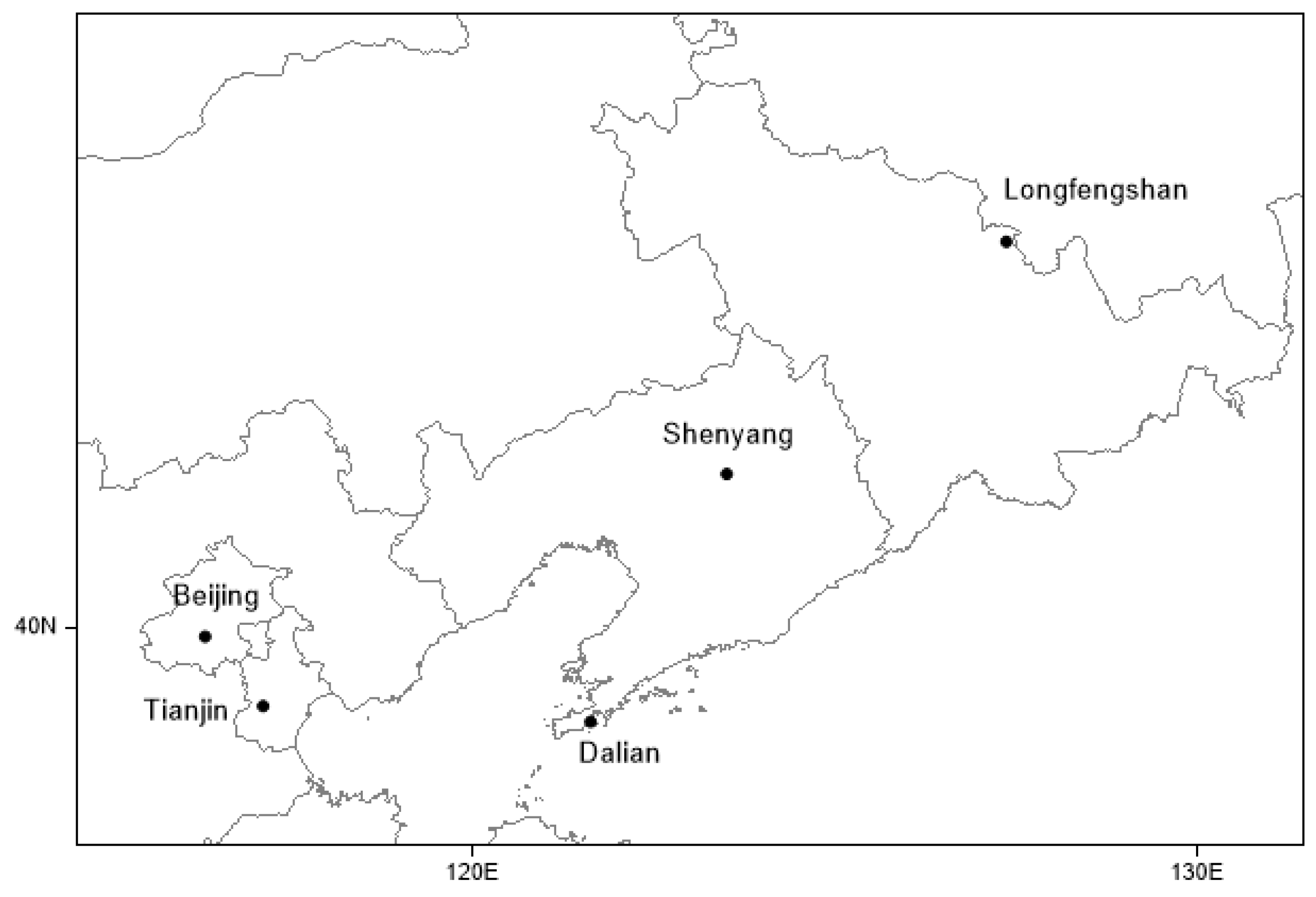
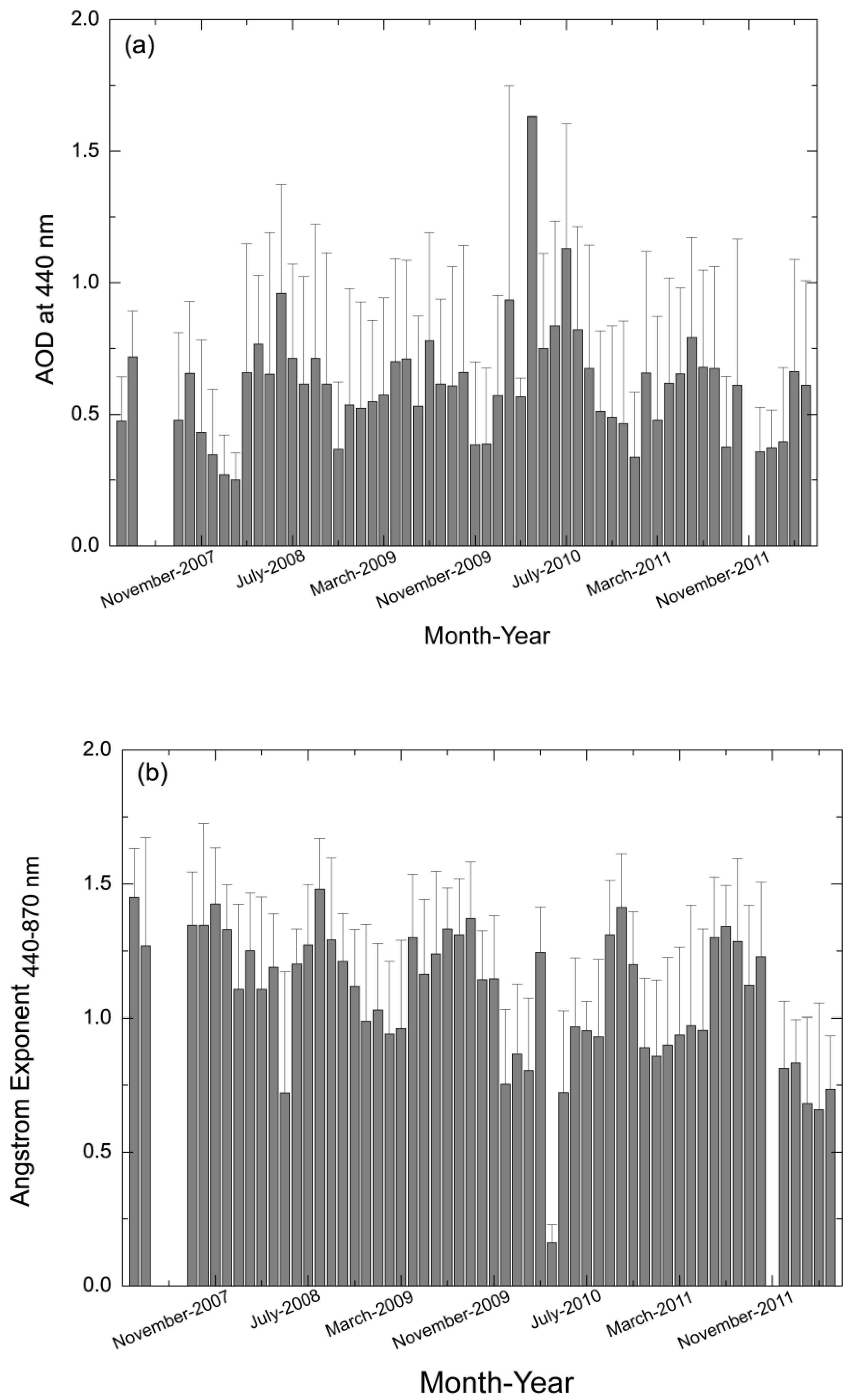
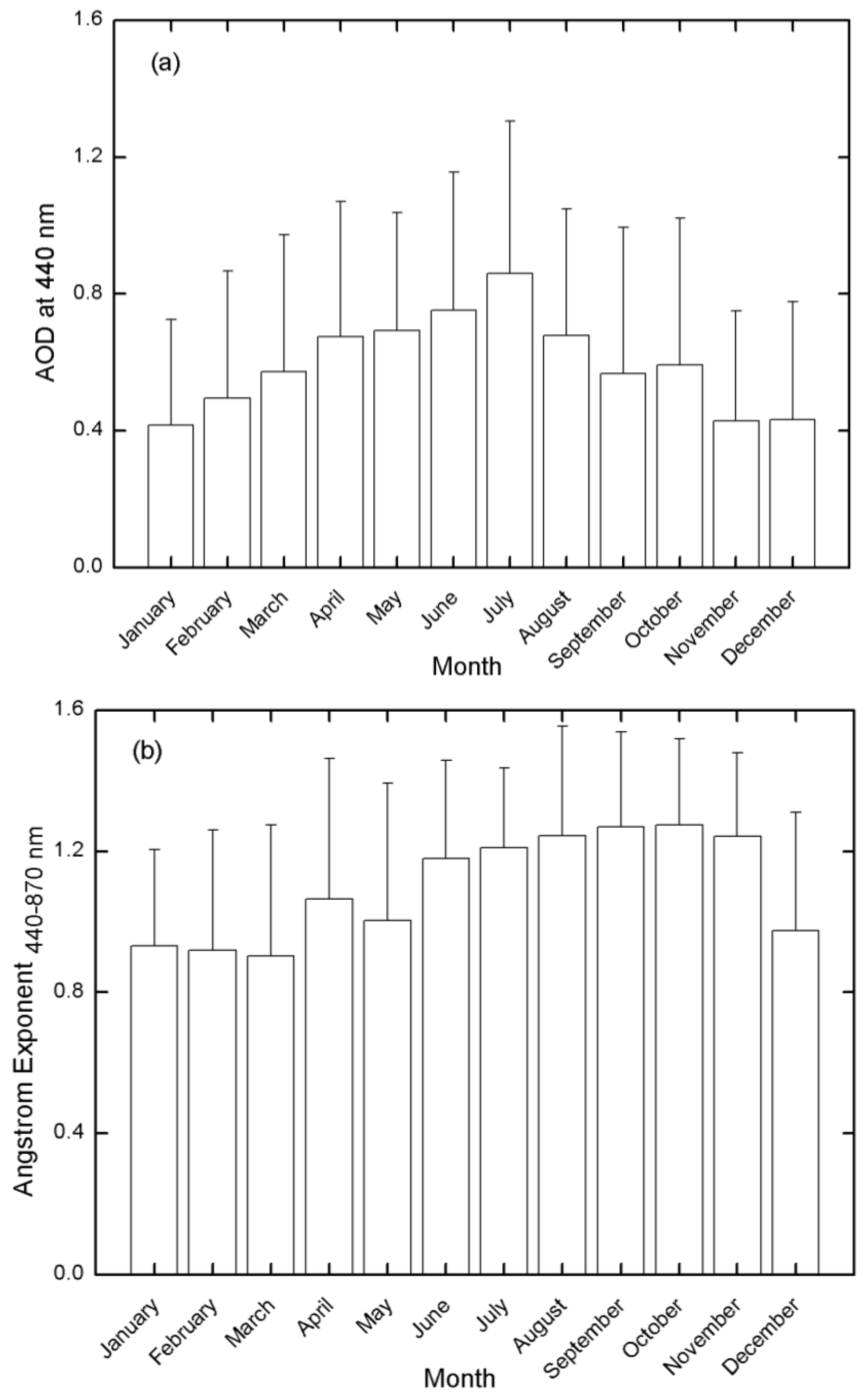
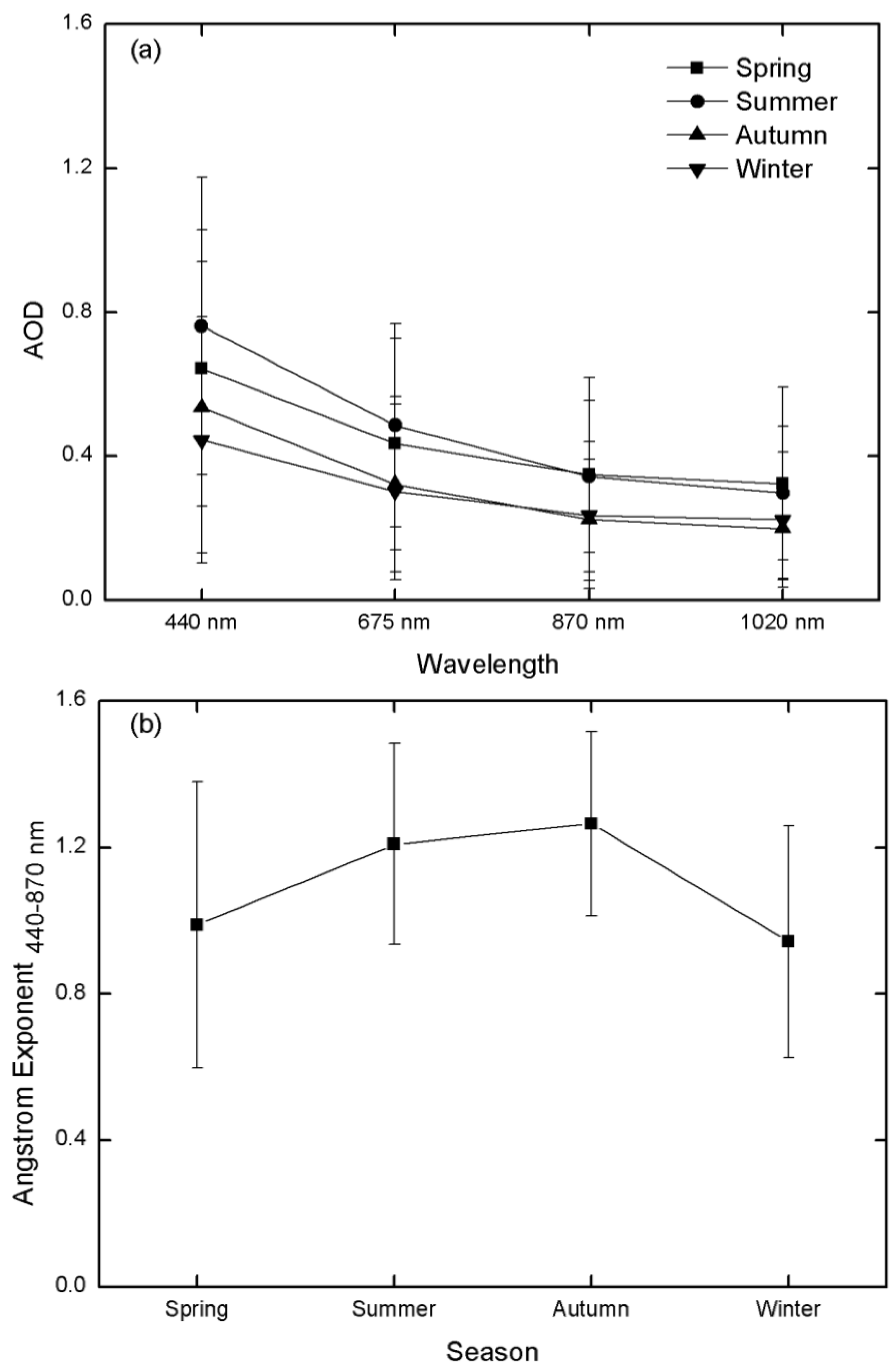
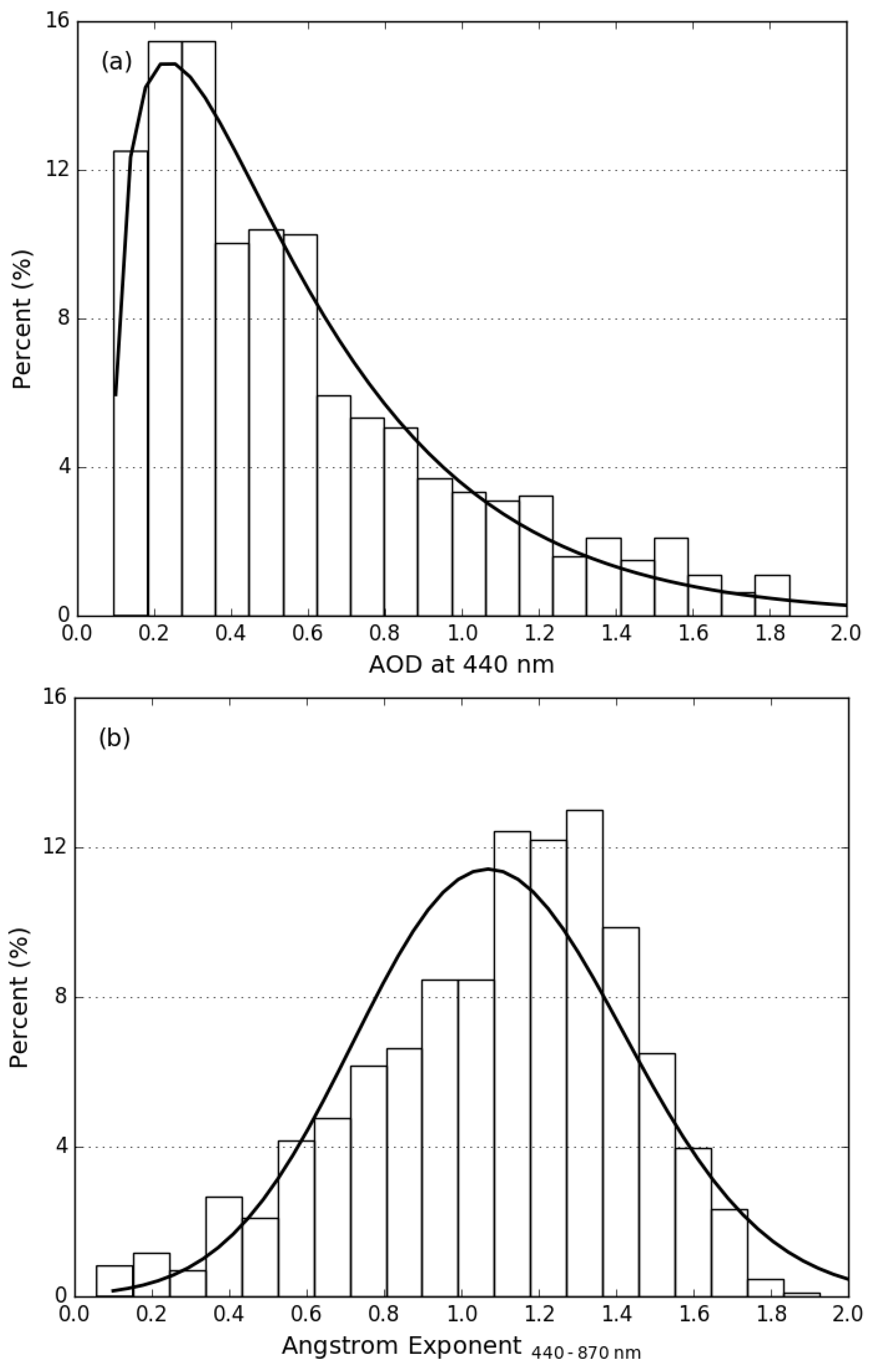
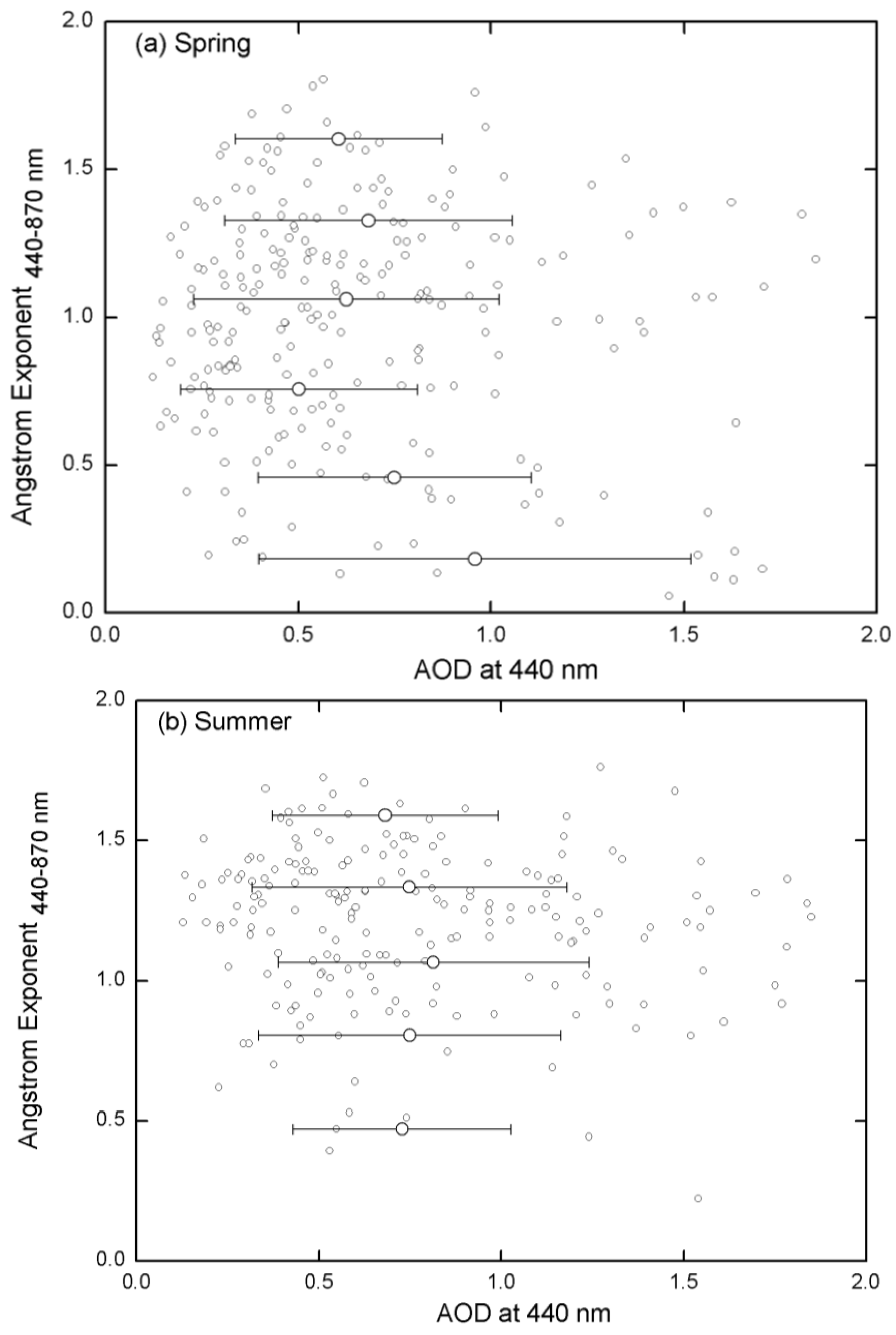

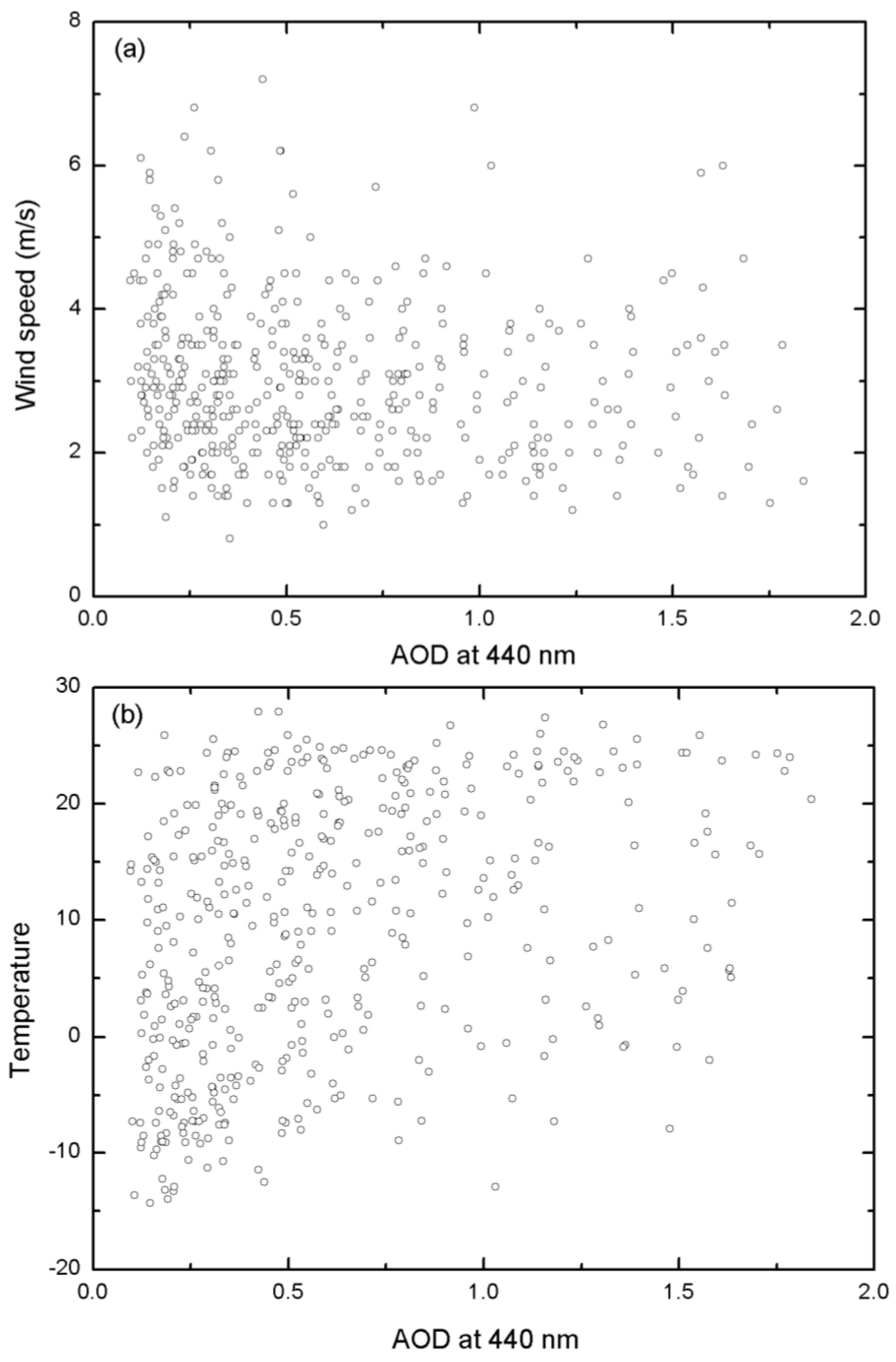
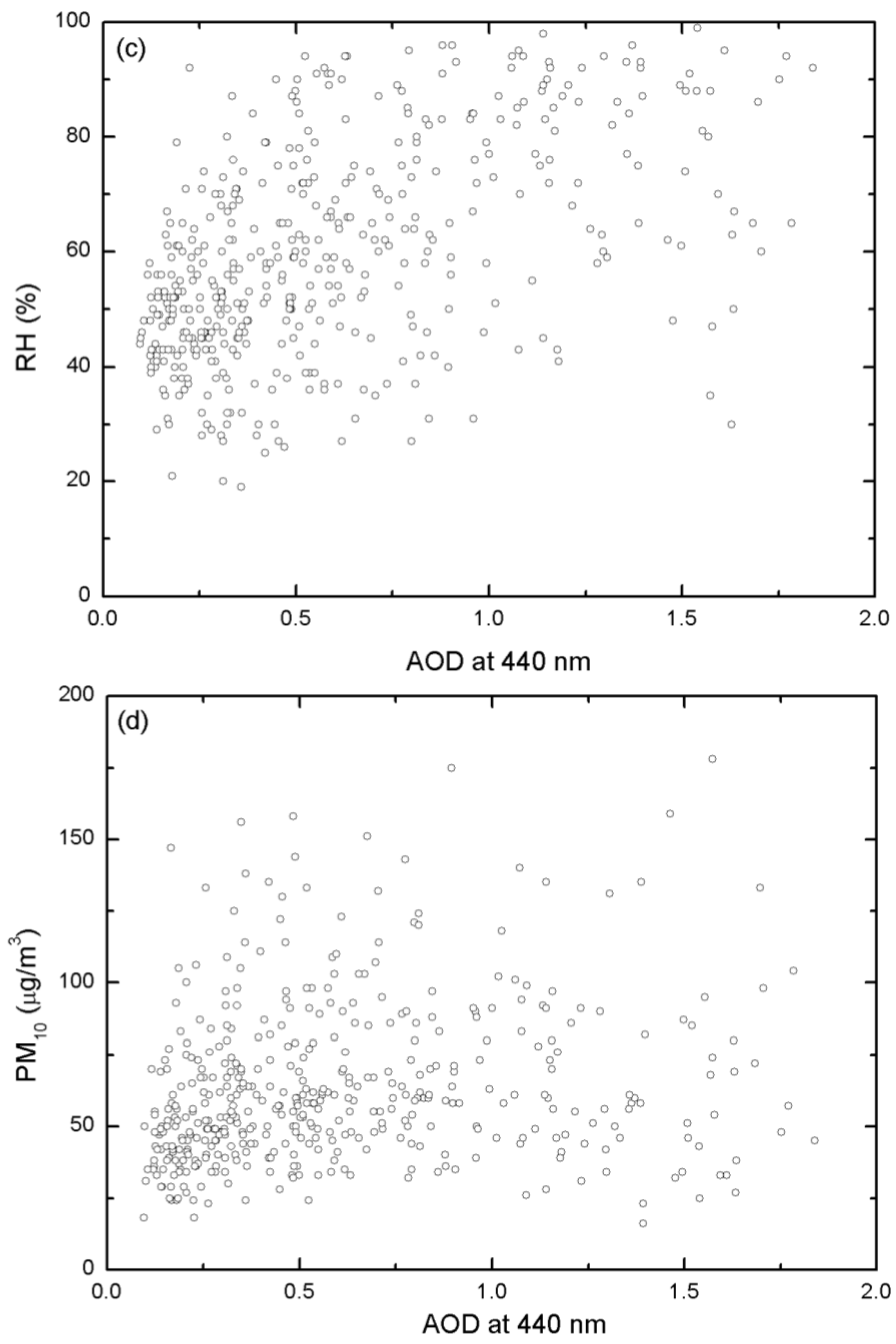
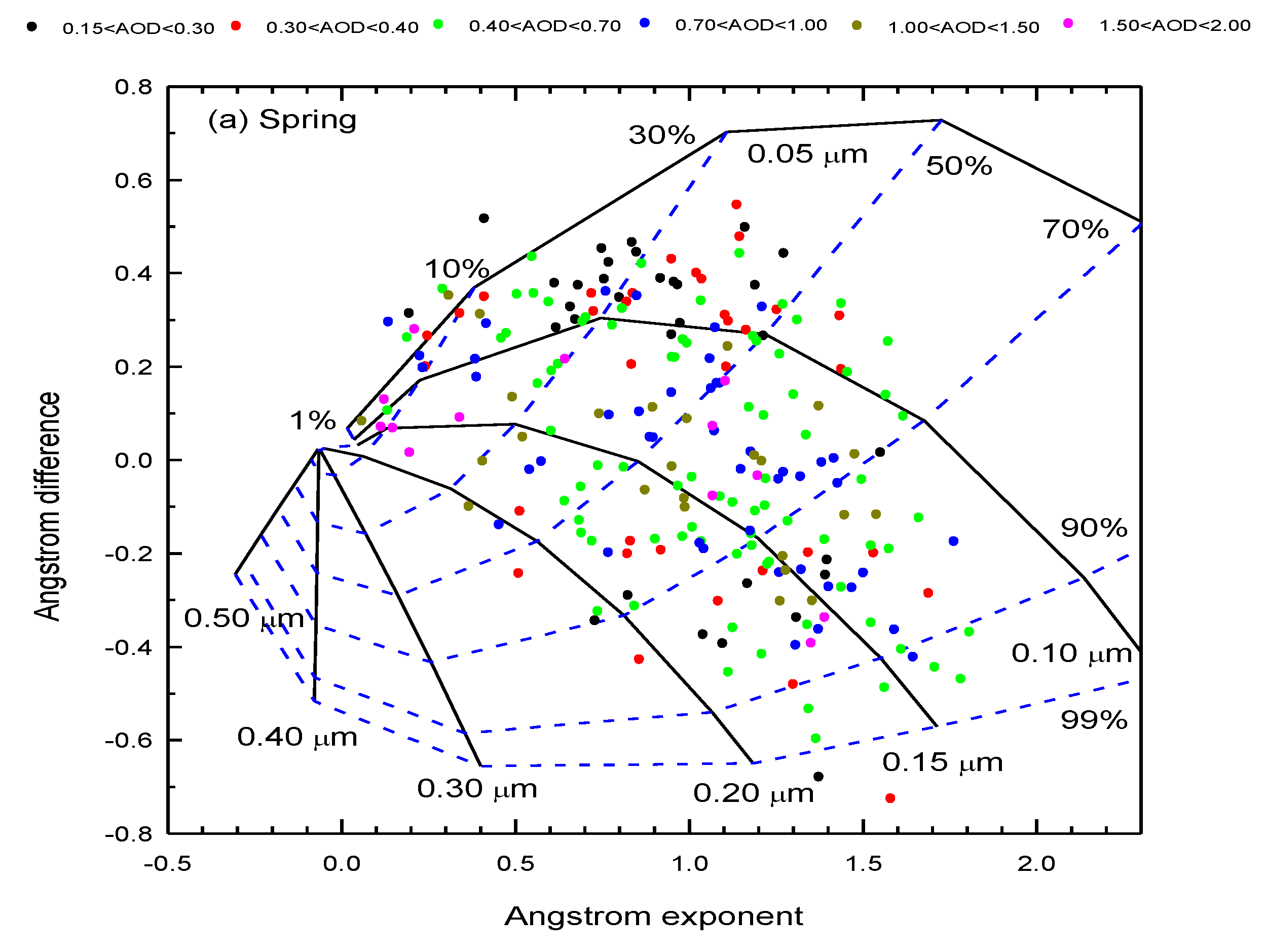
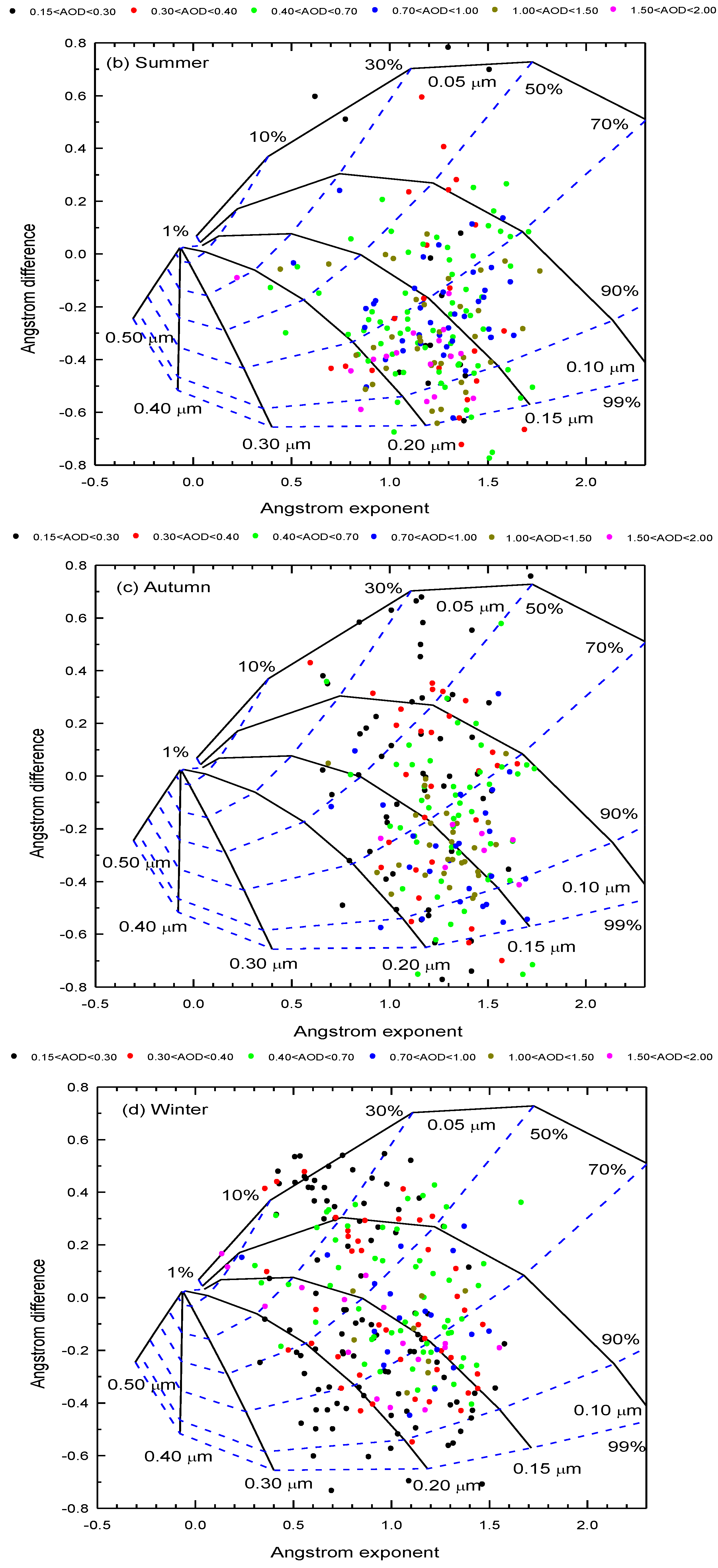
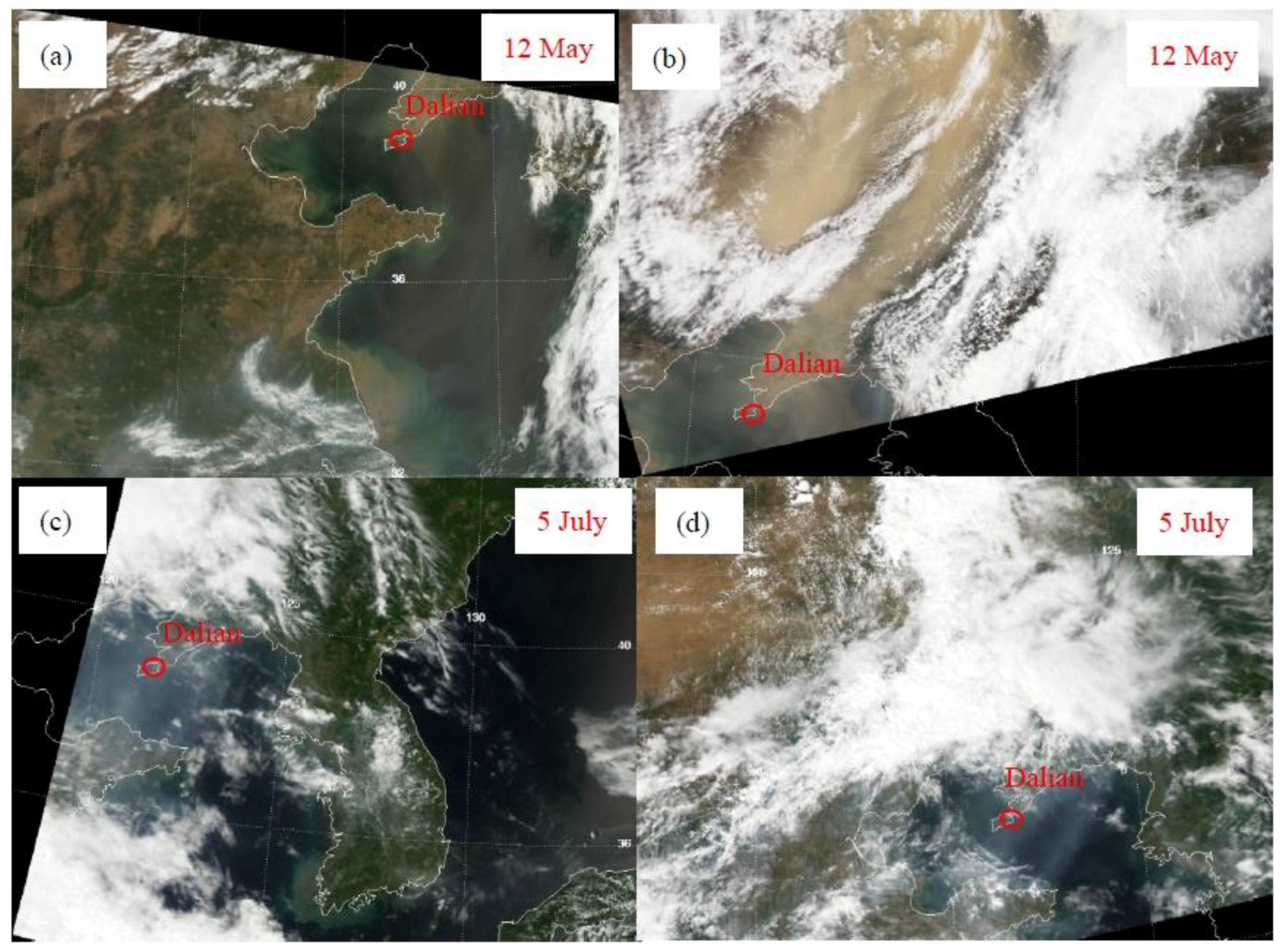
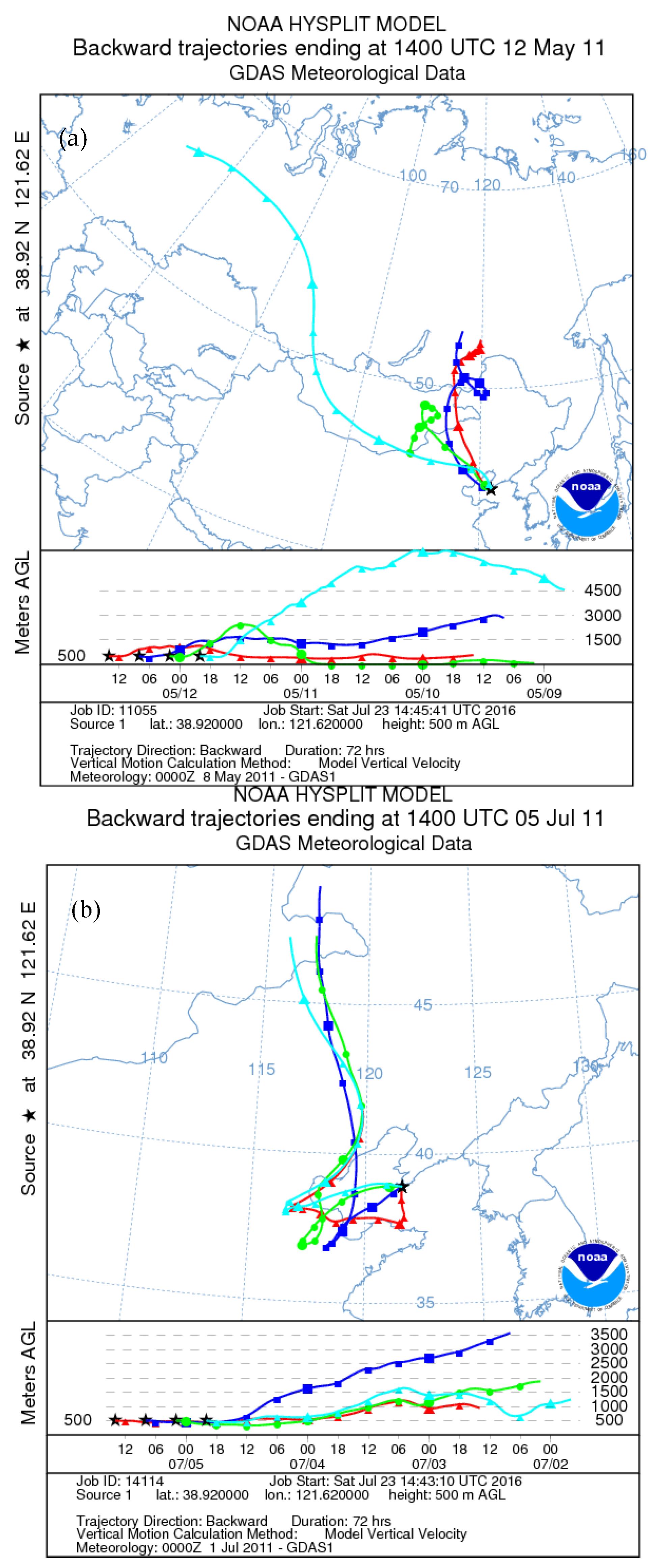
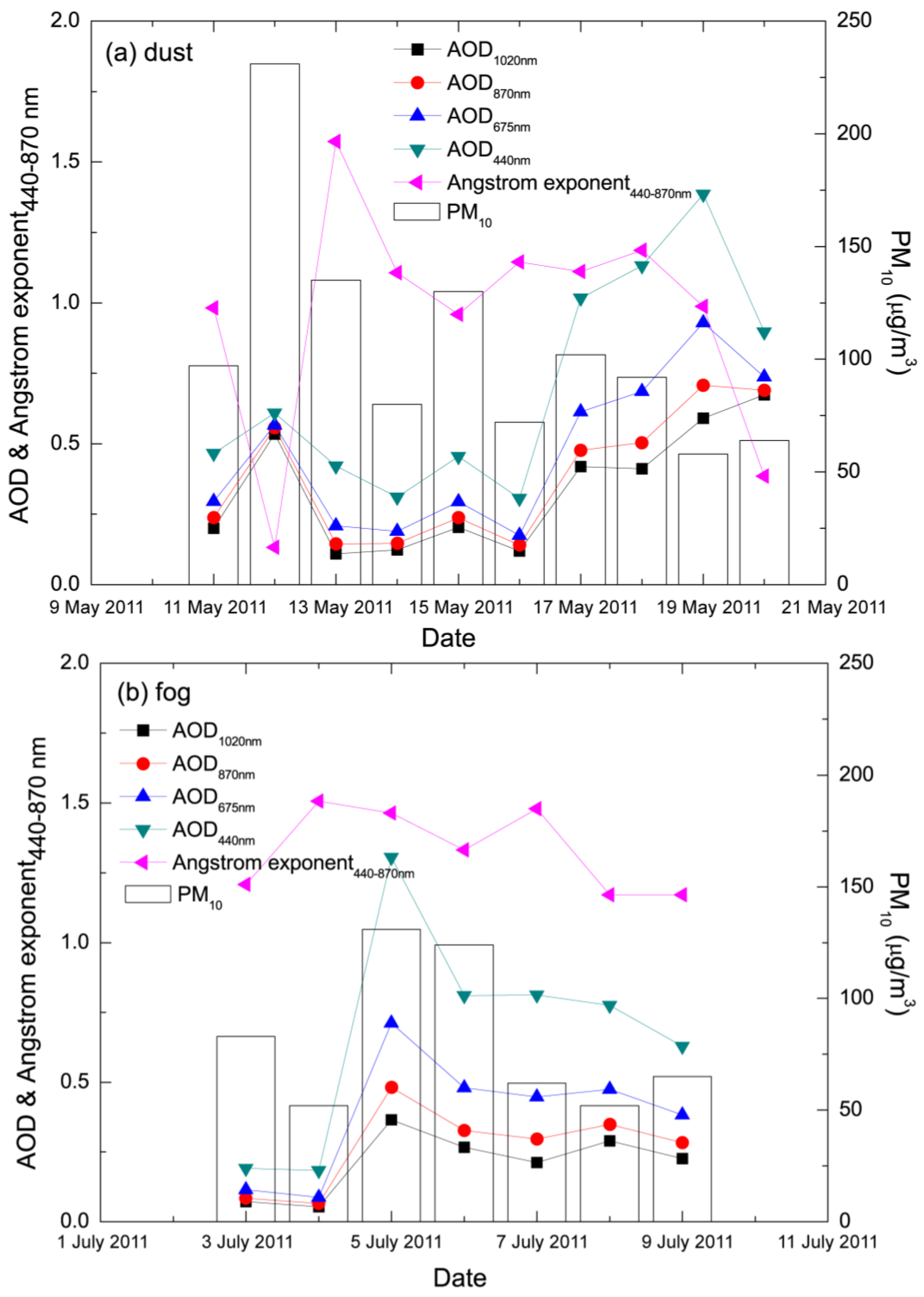
| Number of Days | Number of Instantaneous Data | |||||||||||
|---|---|---|---|---|---|---|---|---|---|---|---|---|
| 2007 | 2008 | 2009 | 2010 | 2011 | 2012 | 2007 | 2008 | 2009 | 2010 | 2011 | 2012 | |
| January | 12 | 26 | 13 | 30 | 16 | 292 | 759 | 149 | 893 | 199 | ||
| February | 15 | 20 | 2 | 23 | 20 | 347 | 597 | 16 | 613 | 422 | ||
| March | 9 | 25 | 2 | 28 | 20 | 175 | 930 | 15 | 1030 | 337 | ||
| April | 6 | 10 | 22 | 2 | 22 | 15 | 304 | 229 | 863 | 10 | 810 | 387 |
| May | 10 | 6 | 23 | 12 | 26 | 313 | 73 | 894 | 315 | 727 | ||
| June | 14 | 25 | 20 | 21 | 192 | 692 | 732 | 477 | ||||
| July | 8 | 22 | 18 | 11 | 96 | 383 | 287 | 218 | ||||
| August | 11 | 20 | 14 | 13 | 121 | 456 | 370 | 289 | ||||
| September | 11 | 20 | 14 | 16 | 22 | 154 | 237 | 167 | 365 | 713 | ||
| October | 5 | 13 | 19 | 27 | 14 | 97 | 185 | 343 | 870 | 422 | ||
| November | 20 | 17 | 7 | 22 | 402 | 453 | 56 | 524 | ||||
| December | 18 | 19 | 17 | 23 | 6 | 365 | 442 | 118 | 466 | 66 | ||
| Range of AOD440 nm | AOD440 nm | Wind Speed (m/s) | Temperature (°C) | RH (%) | PM10 (µg/m3) |
|---|---|---|---|---|---|
| 0.00–0.15 | 0.13 ± 0.02 | 3.6 ± 1.2 | 3.1 ± 10.4 | 46 ± 7 | 44.4 ± 13.1 |
| 0.15–0.30 | 0.22 ± 0.04 | 3.2 ± 1.2 | 2.4 ± 10.6 | 49 ± 12 | 52.3 ± 22.3 |
| 0.30–0.40 | 0.34 ± 0.03 | 2.9 ± 1.2 | 8.2 ± 11.0 | 52 ± 16 | 66.1 ± 26.6 |
| 0.40–0.70 | 0.54 ± 0.08 | 2.9 ± 1.1 | 10.8 ± 10.5 | 61 ± 17 | 68.7 ± 31.3 |
| 0.70–1.00 | 0.83 ± 0.08 | 3.0 ± 1.1 | 14.4 ± 9.2 | 66 ± 18 | 73.6 ± 35.6 |
| 1.00–1.50 | 1.22 ± 0.13 | 2.8 ± 1.0 | 12.9 ± 10.8 | 77 ± 16 | 68.5 ± 32.2 |
| 1.50–2.00 | 1.63 ± 0.09 | 3.0 ± 1.3 | 15.8 ± 8.3 | 74 ± 20 | 67.7 ± 36.5 |
© 2016 by the authors; licensee MDPI, Basel, Switzerland. This article is an open access article distributed under the terms and conditions of the Creative Commons Attribution (CC-BY) license (http://creativecommons.org/licenses/by/4.0/).
Share and Cite
Zhao, H.; Che, H.; Wang, Y.; Wang, H.; Ma, Y.; Wang, Y.; Zhang, X. Investigation of the Optical Properties of Aerosols over the Coastal Region at Dalian, Northeast China. Atmosphere 2016, 7, 103. https://doi.org/10.3390/atmos7080103
Zhao H, Che H, Wang Y, Wang H, Ma Y, Wang Y, Zhang X. Investigation of the Optical Properties of Aerosols over the Coastal Region at Dalian, Northeast China. Atmosphere. 2016; 7(8):103. https://doi.org/10.3390/atmos7080103
Chicago/Turabian StyleZhao, Hujia, Huizheng Che, Yaqiang Wang, Hong Wang, Yanjun Ma, Yangfeng Wang, and Xiaoye Zhang. 2016. "Investigation of the Optical Properties of Aerosols over the Coastal Region at Dalian, Northeast China" Atmosphere 7, no. 8: 103. https://doi.org/10.3390/atmos7080103
APA StyleZhao, H., Che, H., Wang, Y., Wang, H., Ma, Y., Wang, Y., & Zhang, X. (2016). Investigation of the Optical Properties of Aerosols over the Coastal Region at Dalian, Northeast China. Atmosphere, 7(8), 103. https://doi.org/10.3390/atmos7080103






